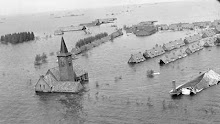I had to visit the medical unit as my glasses were stolen on the train coming from Port Said. I was standing near a door when the train pulled into a station. A local man entered and stood beside me. As the train was moving out of the station, he snatched the glasses from my face and jumped down through the doorway! I had no opportunity to chase him as the train was gathering speed, besides which I could not see very well. The glasses had tortoiseshell frames and were civilian ones that I had purchased in Nottingham before joining up. At Kasfareit camp, the medical unit examined my eyes and immediately provided military glasses with metal frames. The glasses obviously worked well as I was able to resume birdwatching right away.
When my wife recounted this tale to an Egyptian ambassador many years later he asked if I was in RAF uniform. "Yes" she replied. "Well" said the ambassador "what do you expect?" It's true that the British armed forces were an "Army of Occupation" in Egypt as in many other parts of the world in 1946. But I do not think that stealing glasses off the face of a member of those armed forces constituted a gesture carried out to help free Egypt from the occupiers. It was simply an act of opportunistic petty thievery. It taught me to be careful wherever I was in the world, and never happened to me again!
However, the contrast of the ambassador’s interpretation of this event and mine highlights the difference in attitudes between the occupied and the occupiers. In 1946, as a Brit, I could not conceive that I did not have a perfect right to be on the train in Egypt, wearing His Majesty’s uniform. We had just won the war and defeated the German army in North Africa, we were entitled to occupy parts of Egypt in order to control the Suez Canal and I was a tiny cog in the machine set up to achieve this end. The thief may have been quite unaware of ill feeling towards me because of this and saw me just as an easy mark. But the ambassador had been through the 1956 Suez Crisis, had witnessed the humiliation of Britain and the glorification of Egypt, and felt that, earlier, everyone in Egypt must have viewed the British as oppressors.
Another memorable incident occurred on the parade ground, where we all assembled each day for a short while to have our presence checked and to hear any announcements. I brought my binoculars with me and rather rashly put them to use observing the Black Kites ("shite-hawks" as they were called) wheeling overhead. The sergeant in charge of the parade shouted at me "WHAT DO YOU THINK THIS IS? A HOLIDAY CAMP!" Actually, I was amazed at his forbearance as he took no further action - he could have put me on a charge. >>>
“I found that White Wagtails (Motacilla alba alba) and House Sparrows the commonest birds in the camp [presumably after the Black Kites]. In addition there were three Palm [Laughing] Doves* (Streptopelia senegalensis aegyptiaca), a new species to me [and one that would become familiar in many parts of Africa]. I located two nesting sites of this bird on ledges in huts. Neither had eggs though a bird sat tight on one. I also noted a Black Redstart* (Phoenicurus ochurus gibraltariensis) on several occasions in the same part of the camp. It was rather retiring and did not give me much chance to observe it, always vanishing behind a wall or a building.
After tiffin [lunch] on 23 February I took a walk for a few miles in the desert to the SW. Here I saw 6-10 Brown-necked Ravens and several Crested Larks* (Galerida cristata nigricans). There was also a wheatear of indeterminate species, resembling the Northern Wheatear in winter plumage but with a good deal more black on the tail.”


No comments:
Post a Comment